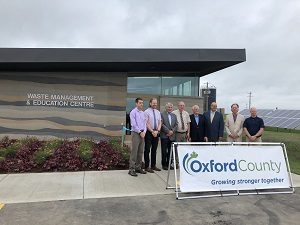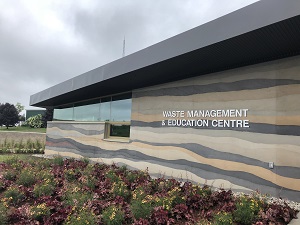Gateman-Milloy’s ‘green’ construction capabilities on display
![]() Print this Article | Send to Colleague
Print this Article | Send to Colleague
 |
 |
“We were delighted to build this exciting project,” says Mike Milloy, President of Gateman-Milloy. “We applaud Oxford County for their leadership in making renewable energy and zero waste a reality, and for the opportunity to demonstrate our team’s sustainable construction capabilities. Our goal is to create all the best places by partnering with our clients to help them realize their visions.”
How energy efficiency drove facility design (from Oxford County)
“The new Oxford County Waste Management & Education Centre is a real-world example of how buildings can be sustainably constructed and operated,” says Peter Crockett, CAO, Oxford County. “It includes demonstrations, resources and information to educate and inspire further sustainability initiatives.”
The new, fully electric building includes a solar photovoltaic system that generates as much electricity as the building consumes on a yearly basis. By incorporating a solar energy system onsite, the annual electrical operating cost for this building is reduced to the fixed charges to remain connected to the electrical grid.
Building performance is designed to meet the 71.5 kWh/m2 requirement of the New Building Institute’s Zero Net Energy criteria. To take things one step further, it was decided that the entire site including not just the newly built facility, but the landfill itself would become a net-zero electricity consumer. Ongoing building performance monitoring will help Oxford County make sure it continues to optimize performance, and will provide valuable energy performance data that will be used to further inform future building designs.
The entire solar photovoltaic system constructed has a designed size of 120 kilowatts, with 24 kilowatts being required to net-zero the building’s energy use.
In addition to utilizing solar energy to achieve net zero, the building itself is designed with energy efficiency in mind. The visually impactful rammed earth walls are 22 inches thick and contain 8 inches of insulation with an R-value of 55. In addition to the heavily insulated walls, there is significant insulation below the floor and in the roof to minimize the amount of electric heating and cooling required.
The building also features triple-pane windows designed to reduce heat loss in the winter, and heat gain in the summer, while allowing natural daylight to reduce the amount of electricity required to power lighting. The building uses highly efficient HVAC equipment for heating and cooling, including two Energy Recovery Ventilators to recover heat energy from the building’s exhaust air and is used to heat the incoming fresh air supply from outside.
Lastly, the building was constructed with a septic system so it won’t be sending waste into the County infrastructure and uses well water so as not to draw on municipal water sources.
About the construction
Gateman-Milloy worked closely with Oxford County to execute the aggressive goals for energy efficiency with the construction of this building. It was the first project for Gateman-Milloy to achieve the net-zero objective and incorporate such a comprehensive solar energy system.
The building is supported on standard concrete footing, and rammed earth walls serve as bearing walls for the wood framed ceiling. Other wood features were worked into the building’s design to give it a rustic aesthetic, including a locally sourced barn board feature wall.
The building envelope and HVAC plan was a significant factor in reaching the net-zero goal. Ninety percent of the HVAC ductwork was cast in place under the slab to help with net-zero requirements and reduce heat losses and gains. Additionally, all seams in the under-slab vapour barrier, as well as the insulation edges and all penetrations were made air tight. Wood windows were used throughout the facility, but required additional measures (sealing) to ensure air tightness. On completion of construction, the building surpassed the design target of 1.0 air changes per hour at 50 Pa (ACH50). The final value achieved was 0.87 ACH50, which is the average of both the pressurization and depressurization tests.
Client satisfaction is Gateman-Milloy’s goal
“This project really embodied everything that the County is looking to achieve with our long-term sustainability goals,” says Mike Amy, Supervisor of Facilities at Oxford County. “The team worked very well together to overcome the challenges of working with high-performance building technologies in order to develop a successful, leading-edge design. It was a great opportunity to learn about energy efficiency and an excellent example of how sustainability can be incorporated into the built environment.”
“This project was a fun challenge,” says Chris Campbell, Project Manager for Gateman-Milloy and lead on the Oxford County assignment. “It gave us the opportunity to showcase what Gateman-Milloy can do for clients who are looking to increase energy efficiency by using sustainable products and technologies in their construction projects.” Chris is a certified LEED green associate and has extensive experience managing projects incorporating green technology.
About Zero Net Energy
NBI tracks the counts and locations of zero energy (ZE) projects across the United States and Canada. ZE buildings are ultra-low energy buildings that consume only as much power as is generated onsite through renewable energy resources over the course of a year. While still a nascent market, the growth trend for ZE is steep. The count of ZE buildings across the United States and Canada has increased by 700% since 2010, and encompasses 45 million square feet of the built environment. ZE has captured the attention of building owners, designers, policymakers, civic leaders, operators and others who see its potential to help reconcile our relationship with the environment using clean energy resources efficiently, reducing substantial carbon emissions of buildings, and eliminating waste.
About Gateman-Milloy
Gateman-Milloy is a respected construction company based in southwest Ontario with a proven track record in both public and private sectors across Canada. What began as a small landscape maintenance and contracting business in 1982 has grown into an award-winning construction firm. Today, Gateman-Milloy offers a full range of construction services, including commercial, industrial, institutional, recreational, residential, design-build and project management. Its unique combination of core competencies and demonstrated experience over the past 35 years is unmatched by others in this sector.
About Oxford County
Located in the heart of southwestern Ontario at the crossroads of Highways 401 and 403, Oxford County has a population of approximately 114,000 people across eight municipalities that are “growing stronger together” through a partnership-oriented, two-tier municipal government incorporated as the County of Oxford. Oxford County is emerging as a leader in sustainable growth through the Future Oxford Community Sustainability Plan and County Council’s commitment to becoming a zero waste community and achieving 100% renewable energy by 2050. Situated in one of Ontario’s richest areas for farmland, agriculture is a key industry that serves as a springboard for some of the sustainable industries that are steadily diversifying the local economy. Oxford County offers a thriving local arts, culture and culinary community, as well as conservation parks, natural areas and more than 100 kilometres of scenic trails. The Oxford County Administration Building is located in Woodstock, Ontario. www.oxfordcounty.ca

